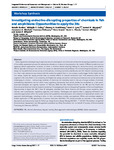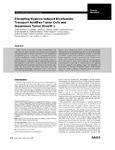ANTECEDENTS AND CONSEQUENCES OF OVERSHOOTING IN THE CONTEXT OF DISRUPTIVE INNOVATION
| dc.contributor.supervisor | Moizer, Jonathan | |
| dc.contributor.author | Zhang, Ye | |
| dc.contributor.other | Plymouth Business School | en_US |
| dc.date.accessioned | 2020-03-04T11:29:27Z | |
| dc.date.available | 2020-03-04T11:29:27Z | |
| dc.date.issued | 2020 | |
| dc.identifier | 10377013 | en_US |
| dc.identifier.uri | http://hdl.handle.net/10026.1/15429 | |
| dc.description.abstract |
Persistently improving certain performance characteristics of products, like functionality, reliability or usability, may make for difficulties in consuming those products, which is the situation of overshooting (Christensen, 1997; Chen, Reilly and Lynn, 2012; Lukas et al., 2013). Overshot customers may consider products as too complex to use, too expensive to buy, too functionally advanced, or too good to have(Christensen, 1997; Thompson, Hamilton and Rust, 2005; Lukas et al., 2013). Prior researchers take overshooting seriously for it may give opportunities to disruptive innovations from the low-end market of the overshooting products (Christensen, 1997; Schmidt and Druehl, 2008b; Hang, Garnsey and Ruan, 2015a; Christensen et al., 2018). However, it is against our common sense that people would be overshot by getting too much of a good thing. Many disruptive innovations' successful disruption over incumbent products, like microscope surgery’s disruption over traditional surgery, are not because incumbent products are too good for customers (Klenner, Hüsig and Dowling, 2013; King and Baatartogtokh, 2015; Zhang, 2015). Moreover, people with intensive demand on certain product performances, like high-end customers, should be hardly satiated by product performance improvement. However, high-end disruptions are still existent and consequent to incumbent’s overshooting on certain performance trajectories of product (Christensen, 2006). This research is thus motivated by those confusing issues to rediscover the mechanisms of overshooting, its antecedents and consequent disruptive mechanisms, and suggest about the coping strategies to overshooting. To achieve the research aims, a longitudinal case study with embedded units of analysis is resorted as natural experiment about an incumbent company and its interactions with three rival disruptors in the higher education market for learning management system. Prior theories and deductive themes are triangulated with the emergent patterns from case data to arrive at a more realistic perceptions towards the problem of overshooting. Also, the theory of path dependence process (Schreyogg and Sydow, 2011) as the underlying mechanism and structure of overshooting will act as the theoretical lens to make sense of overshooting process and its consequent disruption. This research further clarifies from demand perspective that overshooting is decomposable into two dimensions which are ‘compromised performance’ and ‘nonabsorbable performance’. The two dimensions of overshooting may lead to trade-off-reversing disruption and trade-off- breaking disruption as consequences. Also, this research further reveals from supply perspective that there are three different antecedents prior to three different forms of overshooting and consequent disruptions throughout the three-staged overshooting process of a path-dependent organisation (Schreyogg and Sydow, 2011). The coping strategies to overshooting are suggested to vary according to the different stages of overshooting process and the decomposed dimensions of overshooting. Both the demand and supply levels of analysis regarding overshooting and disruption corroborate with each other to arrive at a more holistic and validified reality regarding overshooting as well as its shaping process and consequent disruptive mechanisms. | en_US |
| dc.language.iso | en | |
| dc.publisher | University of Plymouth | |
| dc.rights | Attribution-ShareAlike 3.0 United States | * |
| dc.rights.uri | http://creativecommons.org/licenses/by-sa/3.0/us/ | * |
| dc.subject | Compromised Performance as Overshooting | en_US |
| dc.subject | Nonabsorbable Performance as Overshooting | |
| dc.subject | Trade-off-reversing Disruption | |
| dc.subject | Market Development Disruption | |
| dc.subject | Corrective Emulation | |
| dc.subject | Misfit Overshooting and Fit Disruption | |
| dc.subject | Disruptive Innovation | |
| dc.subject.classification | PhD | en_US |
| dc.title | ANTECEDENTS AND CONSEQUENCES OF OVERSHOOTING IN THE CONTEXT OF DISRUPTIVE INNOVATION | en_US |
| dc.type | Thesis | |
| plymouth.version | publishable | en_US |
| dc.identifier.doi | http://dx.doi.org/10.24382/764 | |
| dc.identifier.doi | http://dx.doi.org/10.24382/764 | |
| dc.rights.embargoperiod | No embargo | en_US |
| dc.type.qualification | Doctorate | en_US |
| rioxxterms.version | NA |
Files in this item
This item appears in the following Collection(s)
-
01 Research Theses Main Collection
Research Theses Main





